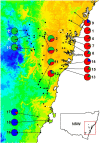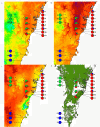The impact of distance and a shifting temperature gradient on genetic connectivity across a heterogeneous landscape
- PMID: 21586178
- PMCID: PMC3112089
- DOI: 10.1186/1471-2148-11-126
The impact of distance and a shifting temperature gradient on genetic connectivity across a heterogeneous landscape
Abstract
Background: Inter-population distance and differences in breeding times are barriers to reproduction that can contribute to genotypic differentiation between populations. Temporal changes in environmental conditions and local selective processes can further contribute to the establishment of reproductive barriers. Telopea speciosissima (Proteaceae) is an excellent subject for studying the effect of geographic, edaphic and phenological heterogeneity on genotypic differentiation because previous studies show that these factors are correlated with morphological variation. Molecular, morphological and environmental datasets were combined to characterise the relative influence of these factors on inter-population differentiation, and Bayesian analyses were used to investigate current levels of admixture between differentiated genomes.
Results: A landscape genetic approach involving molecular and morphological analyses identified three endpoints of differentiated population groups: coastal, upland and southern. The southern populations, isolated from the other populations by an edaphic barrier, show low migration and no evidence of admixture with other populations. Amongst the northern populations, coastal and upland populations are connected along a skewed altitudinal gradient by genetically intermediate populations. The strong association between temperature and flowering time in Telopea speciosissima was shown to maintain a temporally unstable reproductive barrier between coastal and upland populations.
Conclusions: Substrate-mediated allopatry appears to be responsible for long-term genetic isolation of the southern populations. However, the temperature-dependent reproductive barrier between upland and coastal populations bears the genetic signature of temporal adjustments. The extreme climatic events of the last glacial maximum are likely to have caused more complete allochronic isolation between upland and coastal populations, as well as exerting increased selective pressure upon local genomes. However, at intermediate altitudes, current climatic conditions allow for the incorporation of alleles from previously distinct genomes, generating new, intermediate genomic assemblages and possibly increasing overall adaptive potential.
Figures




References
-
- Coyne JA, Orr HA. Speciation. Sunderland, Massachusetts: Sinauer Associates; 2004.
-
- Templeton AR. Book Population genetics and microevolutionary theory. City: Wiley Online Library; 2006. Population genetics and microevolutionary theory. (Editor ed.^eds.)
-
- Nosil P, Vines TH, Funk DJ. Reproductive isolation caused by natural selection against immigrants from divergent habitats. Evolution. 2005;59:705–719. - PubMed
Publication types
MeSH terms
LinkOut - more resources
Full Text Sources

